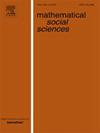两个agent间图形饼加权共识划分的连通性
IF 0.7
4区 经济学
Q4 ECONOMICS
引用次数: 0
摘要
Austin的动刀程序最初是为了在两个代理之间找到间隔/圆形蛋糕的共识划分,每个代理都认为他们得到了蛋糕的一半。我们用两种方式来概括这一点:我们考虑用图形建模的蛋糕,并让两个代理具有不平等的、任意的权利。在这种情况下,我们寻求一个加权共识划分——每个代理都相信他们得到了他们有权得到的份额——这也最小化了每个代理收到的连接组件的数量。首先,我们回顾了圆形蛋糕的加权共识划分,它给每个agent精确地分配了一个连接块。接下来,通过明智地将一个圆映射到一个图,我们产生了星图饼的加权共识划分,该划分给每个代理最多两个连接块,并表明连接块数量的这个界限是紧密的。对于树,每个代理最多接收到h+1个连接的片段,其中h是树的最小高度。对于连通的图饼,每个agent接收r+2个连通的块,其中r为图的半径。最后,对于具有s个连通分量的图饼,划分最多涉及s+2r+4个连通块,其中r为所有连通分量的最大半径。本文章由计算机程序翻译,如有差异,请以英文原文为准。
Connectedness in weighted consensus division of graphical cakes between two agents
Austin’s moving knife procedure was originally introduced to find a consensus division of an interval/circular cake between two agents, each of whom believes that they receive exactly half of the cake.
We generalise this in two ways: we consider cakes modelled by graphs, and let the two agents have unequal, arbitrary entitlements. In this setting, we seek a weighted consensus division – one where each agent believes they received exactly the share they are entitled to – which also minimises the number of connected components that each agent receives.
First, we review the weighted consensus division of a circular cake, which gives exactly one connected piece to each agent. Next, by judiciously mapping a circle to a graph, we produce a weighted consensus division of a star graph cake that gives at most two connected pieces to each agent — and show that this bound on the number of connected pieces is tight. For a tree, each agent receives at most connected pieces, where is the minimal height of the tree. For a connected graphical cake, each agent receives connected pieces, where is the radius of the graph. Finally, for a graphical cake with connected components, the division involves at most connected pieces, where is the maximum radius among all connected components.
求助全文
通过发布文献求助,成功后即可免费获取论文全文。
去求助
来源期刊

Mathematical Social Sciences
数学-数学跨学科应用
CiteScore
1.30
自引率
0.00%
发文量
55
审稿时长
59 days
期刊介绍:
The international, interdisciplinary journal Mathematical Social Sciences publishes original research articles, survey papers, short notes and book reviews. The journal emphasizes the unity of mathematical modelling in economics, psychology, political sciences, sociology and other social sciences.
Topics of particular interest include the fundamental aspects of choice, information, and preferences (decision science) and of interaction (game theory and economic theory), the measurement of utility, welfare and inequality, the formal theories of justice and implementation, voting rules, cooperative games, fair division, cost allocation, bargaining, matching, social networks, and evolutionary and other dynamics models.
Papers published by the journal are mathematically rigorous but no bounds, from above or from below, limits their technical level. All mathematical techniques may be used. The articles should be self-contained and readable by social scientists trained in mathematics.
 求助内容:
求助内容: 应助结果提醒方式:
应助结果提醒方式:


